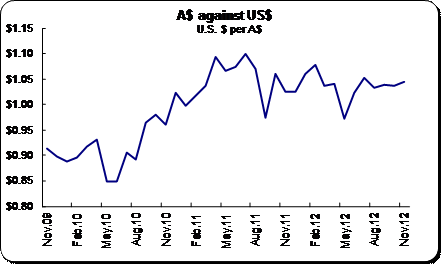|
Australian dollar (A$)
The relatively high value of the Australian dollar had been driven in part by the strong demand for its exports and the interest rate spread between those in Australia compared with the U.S., EMU and Japan. While the yen has been on the borrowing end of carry trade transactions, the Australian dollar has been on the investing side of the equation because of the higher yields available there. With the onset of the credit crunch, funds were repatriated as investors became risk averse and ditched carry trade positions. Since hitting a low in January 2009, the Australian dollar has continued to rise for the most part as investors came to terms with risk and as equities climbed. Interest rates remain high here in contrast to other economies which is luring investors seeking yield. The Reserve Bank of Australia’s seven rate increases had enhanced the currency’s global appeal. The currency weakened somewhat after the RBA lowered interest rates at the end of 2011 and as the Eurozone sovereign debt crisis sent investors looking for safety in the yen and the U.S. dollar. Investors shed risk in May as worries about Europe escalated once again and the Australia dollar dropped in value against its major counterparts. The currency rebounded as tensions eased temporarily in June and July but eased again in August. The Aussie advanced once again in September but edged down in October. It gained again in November.

|